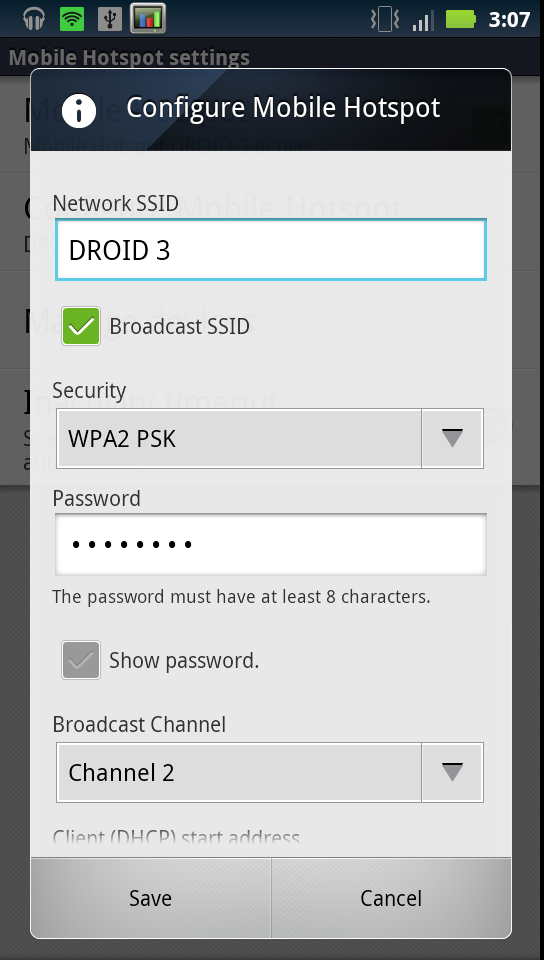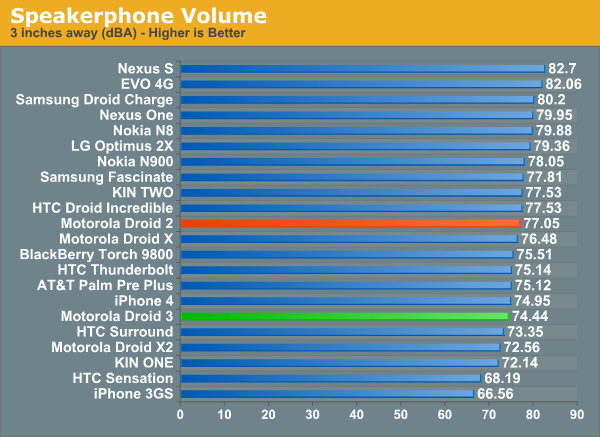Motorola Droid 3 Review - Third Time's a Charm
by Brian Klug on July 30, 2011 12:01 AM ESTWiFi Hotspot
Like most all other Android phones, the Droid 3 supports creation of a mobile WiFi hotspot, and does so through some custom Motorola software rather than the stock android host AP tool. The Droid 3 allows a maximum of 5 simultaneous users on its WiFi hotspot, and unlike the X2, I was able to test this out and run our hotspot battery life test and also stress test a bit. The configuration tool thankfully allows specification of which channel to use (something most others don’t) alongside the typical WPA2 PSK/open configuration and of course SSID. The software also gives control over individual connected devices, showing a list and also providing a notification when devices attach and detach.


I encountered no bugginess at all with the Droid 3’s mobile AP when using it at cafes or when out and about. It’s effectively the same software used across the entire Motorola Droid lineup with the latest respective updates.
Speakerphone Quality
Next up is speakerphone, which is important of course not only for voice calling but also playing back music and using Google navigation. I talked about the car dock already, and the real assumption is that you use the car dock in conjunction with either A2DP to a bluetooth head unit, or use a supplied 3.5mm audio cable that jacks into your car’s aux jack, if you’re lucky enough to have one. Sadly, my car lacks both bluetooth and an aux jack, and has no tape deck or easy other means of getting audio in, so having a loud speakerphone for route guidance is very important.
The Droid 3’s speakerphone is on the back and changed considerably from the previous generation Droid and Droid 2 which previously stuck it under a grille next to the battery. Instead, the Droid 3 has a small, long port with a raised top lip to prevent the port from laying completely coplanar with a table and directing no audio out. Next to it, centered, is a microphone which aids in noise cancellation and also stereo audio capture.

We measure speakerphone volume by placing a call to the test ASOS locally and using a digital decibel meter placed 6” above the device with its display face-up and on maximum volume. By the charts, the Droid 3 honestly isn’t as loud as its predecessors. Subjectively, I agree with the results - it isn’t as loud as I wish it could be while using Google navigation, but there’s no distortion on the speaker at least.
Call Quality and Noise Rejection
Last but not least in this section is actual call quality, which we’ve done a bit more analysis on with the Droid 3 than normal. I think we’re starting to settle on a call testing suite that’s representative, though some non-subjective tests are still being derived.
The first thing we’ve done is place calls to the local ASOS number and record them with the Droid 3 on three different voice coders. By default, virtually all CDMA2000 1x voice devices use EVRC, however there’s another EVRC-B voice coder which adds a quarter rate, and the highest quality 13k voice coder which is sort of a legacy standard that sounds better but uses more bandwidth. I’ve tested the same number with all three and tossed them up on soundcloud. This is of course a recording taken by running line-out from the Droid 3 to line-in and recording.
The Droid 3 subjectively sounds excellent in call tests, definitely better than the average CDMA2000 phone. In addition, I decided to test another thing - ambient noise cancellation on the Droid 3 when in a noisy environment. I noted earlier that the device has three microphones, one at the very top, one on the back, and one on the front at the lip of the device.
To test this, I called a couple of parties in a loud environment playing back music and increased volume, asking them if they could hear the background noise. Only at the highest settings did they report hearing any background noise at all. I went on to then test by recording the call and likewise playing back loud music. I compared to the iPhone 4 and made two recordings where background music (which included vocalizations in addition to instrumentals). Only at the highest (almost painful) volume levels is background noise audible to the receiving party, as illustrated in the recordings I’ve uploaded and provided below. The Droid 3 arguably performs better than the iPhone 4 at noise rejection which is quite a landmark considering its longstanding reputation as having excellent noise rejection.
Motorola Droid 3 to AT&T iPhone 4 by AnandTech AT&T iPhone 4 to Motorola Droid 3 by AnandTechThe Droid 3 has excellent ambient noise cancellation during calls, again thanks to the two extra microphones which are no doubt used for processing. I’m not sure what IP is beyond the Droid 3’s noise rejection hardware, but clearly it does a good job.










84 Comments
View All Comments
RoninX - Sunday, July 31, 2011 - link
I'm guessing that people who prefer a physical keyboard (like myself) would rather manually correct spelling errors than deal with <a href="http://damnyouautocorrect.com/">overly aggressive autocorrect algorithms</a>.I currently have a Droid 2 on a one-year contract that's eligible for an upgrade, and I'm strongly learning toward getting a Droid 3, due largely to the excellent keyboard.
I'll have to see the Pentile screen in-person before making a decision. I find it interesting that some people find the Pentile effect imperceptible, while others find it unbearable.
I'm also curious about the Samsung <a href="http://www.bgr.com/2011/07/29/atts-sleek-samsung-s... which looks like a dual-core Exynos slider. The keyboard doesn't look nearly as good as the Droid 3's, but the 3000+ score on Quadrant (similar to the SGS2) is intriguing...
RoninX - Sunday, July 31, 2011 - link
That should read, the Samsung http://www.bgr.com/2011/07/29/atts-sleek-samsung-s...">SCH-i927 dual-core Exynos slider.hackbod - Monday, August 1, 2011 - link
Auto-correcting input from a hard keyboard is actually very different than from a soft keyboard. A soft keyboard's auto correction is deeply tied to the key layout, and tables built to map specific tap positions on the keyboard to the possible letters that may be intended.The Android IME architecture *does* allow the IME to perform the same kinds of text processing operations on physical keyboard input as it does on touch input. However, in practice, a soft keyboard IME is designed around processing touch input, and you probably wouldn't want it to do the same processing of hard key input because the result would be poor.
jvchapman - Saturday, July 30, 2011 - link
No 4G = Useless.bjacobson - Saturday, July 30, 2011 - link
looks like the display is still sunken down under the gorilla glass like on the Droid1 and Droid2? The more I use others' phones (Samsung Galaxy, Iphone, etc) the more it bugs me on mine...significantly increases glare.bjacobson - Saturday, July 30, 2011 - link
The dragging down notifications bar animation, on all the OMAP based phones I played with, runs at 20-30 FPS best case.The Samsung Galaxy animation for it is much smoother for whatever reason.
This is the biggest beef I have with android phones; I play with my friend's Iphone 3gs and it's still smoother than the latest android hardware...
Mumrik - Saturday, July 30, 2011 - link
I really don't get why we have to have those sucky touch buttons under the screen when they could be proper physical buttons.Myrandex - Monday, August 1, 2011 - link
I agree. I miss call start and end buttons personally.Jason Cook
anandtech pirate - Saturday, July 30, 2011 - link
only 512mb of ram? I'm sure throwing in another 512mb wouldn't have added much to the cost. and I bet the performance boost would have been worth it.also..... whatever happened to the evo3D review?.... just wondering like a lot of other people
tipoo - Saturday, July 30, 2011 - link
Does anything indicate 512MB currently bottlenecks Android or its apps? We just moved away from 256MB not so long ago, after all.